All about the road sign "Bicycle path"
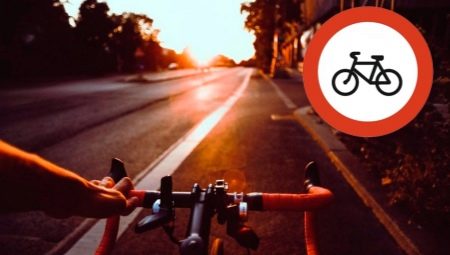
Cycling is not just a sport. Over the past 10-15 years, the bicycle has turned into a full-fledged form of transport, allowing you to get to the other end of a congested metropolis in an hour and a half. In those years, when cyclists first began to go out into the streets, and traffic regulations were formed, aimed specifically at this category of citizens.
A cyclist is also a driver, but not a car, but his own bike. He is a full-fledged road user. For cyclists, there are a dozen warning, prohibition and prescriptive signs on the roads, and among them - the sign "Bicycle path".

What does it mean?
This sign indicates to drivers of cars and motorcycles, pedestrians, that they are crossing or reaching the beginning (or end) of the cycle path.
- When crossing a cycle path, the driver of a car or motorcycle slows down. If the bike path is not visible (for example, due to trees, houses and buildings, a fence, etc.), the driver must slow down or reduce the movement of his vehicle to a very low speed. Quite often there are cyclists driving right under the wheels of passing cars.
- The motorist has no right to ride on the bike path, even when the entire area of the road or the site is allotted for it. It is better for him to get to the nearest auto-intersection and bypass this place. But according to statistics, there are dozens of daily violators for one specific cycle path.
- A pedestrian is also not allowed to walk on the bike path if there is a sidewalk nearby.If there is no sidewalk, he must control the situation by risking a cycle or road. However, hundreds of pedestrians, passing next to the bike path, walk along it every day, apparently taking the "Bicycle path" sign for the decoration of the road.

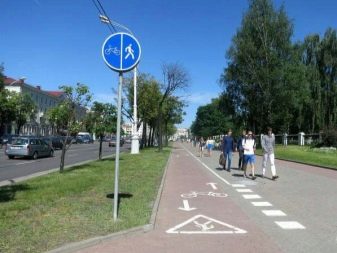
So, a cycle path is needed to reduce accidents when cycling. It is also a guarantee of safety for pedestrians and car drivers. In many Russian cities, especially in small ones, there are no bike paths at all. In European cities, a cycle path must pass next to every highway, street or avenue. - several times more than ours, the number of citizens use a bicycle for solving everyday tasks.
Russian cyclists are forced to risk their lives by constantly driving onto and crossing avenues. Their safety is partly ensured by traffic lights. With a green light for his stream, in which a single cyclist is moving, he begins to move at the same time as everyone else. Together with other participants in the same traffic, he stops, noticing that the red light will now turn on (or has already turned on). Often, the cyclist follows the instructions for drivers, turning left at an intersection with the participants in his lane. And wherein he does not give any signal that he wants to turn there. And this is already considered a violation of traffic rules.
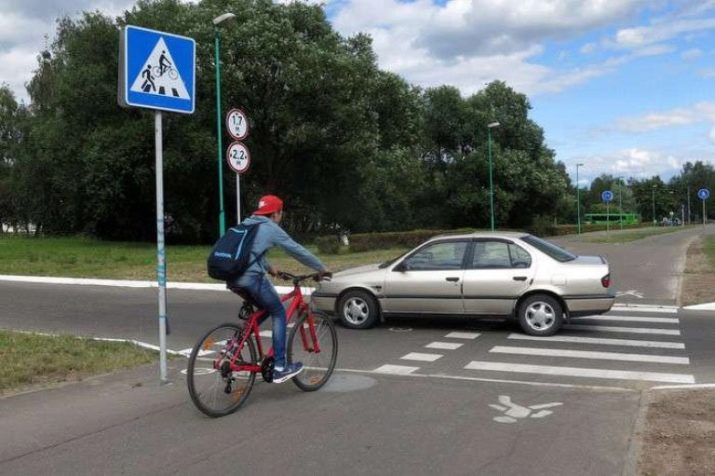
What does it look like?
The Bicycle Path sign is the symbol on the blue circle of the silhouette of a white bicycle (side view). The circle is outlined with a white line around the circle. The same image, but crossed out with a red line, means “end of the cycle path”.
There are other signs:
- "The movement of cyclists and pedestrians" - a warning sign serving as a prescription for those and other groups of road traffic that only they can move here. Driving together requires pedestrians and cyclists to give way to each other.
- "The movement of cyclists is prohibited" - means that a cyclist cannot pass here, because it interferes with constant and active traffic. This street or road may have many access roads. Cycling here can cause massive accidents.
- "Crossing the bike path" - informs about the priority of the car.
These signs sometimes indicate the time of day during which it is allowed to ride a bicycle on a particular road.

In recent years, traffic lights have also been converted to meet the needs of cyclists. For cyclists, a fourth green or tricolor peephole is placed, on the glass of which a stencil with the image of a bicycle sign will be applied. In this case, the traffic lights are supplemented with a separate microcontroller that controls the glow color of this peephole, or they are reflashed for direct work with it.
Where can you meet?
The "Bicycle path" sign is installed:
- to the right of the dedicated lane delimited from the road and sidewalk either by curbs or by a lawn;
- immediately after each intersection with a road - when the cycle path does not end after it;
- near the buffer zone of the road or on the other side of the parking spaces where there is a pedestrian and bicycle part;
- on the streets on which traffic is closed for vehicles;
- on embankments where there are paths suitable for cycling;
- in the area of narrow streets and on bridges, where traffic is provided for cyclists;
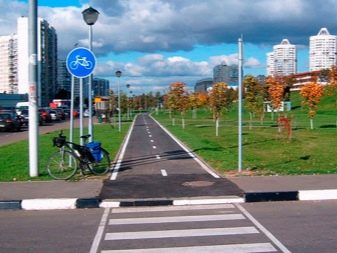
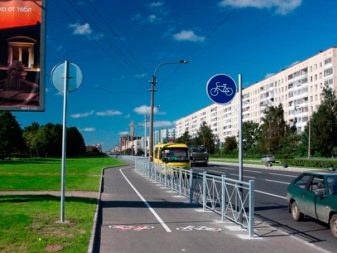
The last three options are of little use when there are obstacles in the form of:
- crowds of pedestrians scurrying back and forth;
- non-compliance with the speed limit for cycling (near houses - up to 20 km / h, on bike paths - up to 30);
- a sharp narrowing of the zone, leading to frequent collisions of cyclists with each other (with oncoming traffic) and pedestrians.
The lane should be marked appropriate marker. The sign itself (and markings) is often found in parks and squares.In megalopolises, a cycle path is a frequent occurrence for the central part of the city, which creates comfort for all road users. Often it is one-way - the direction of movement along it coincides with the adjacent traffic lane.
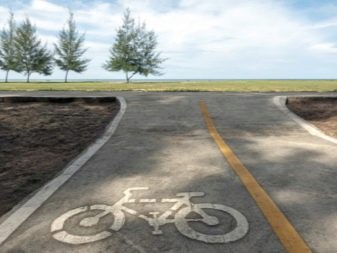
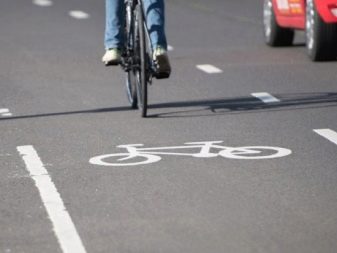
The authorities of some European countries have provided for separate traffic lights, thereby creating an infrastructure for cyclists, very similar to automobiles.
In Russia, this phenomenon has not yet taken root.
It is a good sign if the bike path is fenced off from the carriageway by handrails, reinforced concrete floors or a fence, has access edges smoothed with the road and is two-lane. The direction of movement of the lanes must also be marked. Exits to the road should be located so that it would be difficult for cars to enter the cycle path.
In Norway and Sweden, bike paths are often connected to sidewalks. If it were not for the markings and the "bike" stencil, you would not have paid any attention to the bike path.
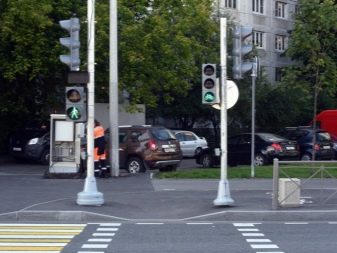
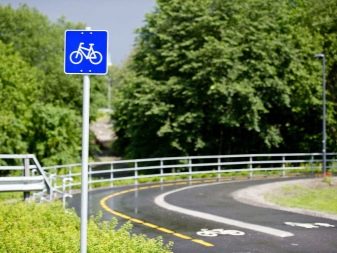
What rules need to be followed?
If you think that, having got on a bike, you will be anonymous and uncontrollable, arbitrarily leaving the avenues and moving around places where people congregate and rest, while not respecting the interests and rights of others, immediately throw these thoughts out of your head.
Speed and order of movement
Once on the bike, the cyclist assumes the need to perform the following actions in situations that require:
- when turning to the left, he raises his arm bent at the elbow - and points in that direction, similarly - to turn to the right;
- when braking when entering a cycle path from a general road, he raises one of his hands;
- when entering a cycle path from a general-purpose road without having to slow down, he indicates with an outstretched hand the direction in which he will move;
- a cyclist can cross roads at intersections only when cars give him the way;
- if it is necessary to cross the road, the cyclist slows down and lets cars pass, then goes on;
- if the path does not cross the road, but ends, and only a pedestrian crossing goes further, the cyclist must get off the bike and cross the road on foot;
- if a cyclist moves on an electric bike (or a bicycle converted to a gasoline engine), then his speed is limited to 60 km / h, as for motorists, in adjoining areas, parks and squares, he should not ride at a speed exceeding 20 km / h;
- children under the age of 14 do not have the right to independently drive on public roads;
- cyclists can ride behind a continuous strip (shoulder) of a track or avenue, moving in groups of 10 people;
- it is allowed to carry cargo on the trunk, which does not interfere with the control of the bike;
- a cyclist carrying a child under 7 years old can ride in the pedestrian zone;
- the cyclist must sharply slow down if the car in front turns to the right, this is evidenced by the right turn signal turned on by the driver of the car - wherever he turns;
- having driven to the end of the cycle path and stumbling upon the appropriate sign, the cyclist is obliged to further get off the bike and drive it, holding the handlebars;
- if there is still a cycle path near the highway or road of the street (avenue), the cyclist has no right to join the general traffic;
- it is necessary to turn on the rear red and front white lights in the dark, in fog and when driving through a tunnel;
- it is prohibited to tow bicycles by any means, except for driving a bicycle trailer, which also has red marker lights.
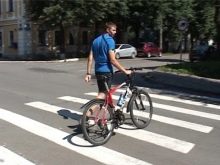

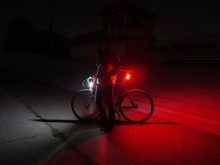
In the absence of a two-lane cycle path, oncoming cyclists can be difficult to move.
Although a cyclist must let cars pass when crossing a road, in practice drivers are more likely to let cyclists pass. This is due to the fact that single cyclists come across more often than those that ride in groups.Many of them may not know the traffic rules at all until they get behind the wheel of a car. In turn, drivers do not need accidents with all the consequences: it is easier to miss a cyclist than to fix the car and be responsible for other consequences of the accident before the law.
Sign coverage area
The action of the sign begins at the beginning of the path, near which it is installed, and ends when the path meets a turn or intersection, or the sign "End of the cycle path".

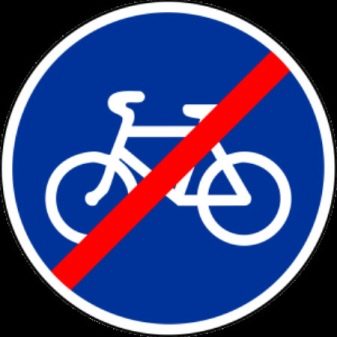
Changes in traffic rules for cyclists
The authorities did not just introduce separate concepts for people whose vehicle is a bicycle, not a car. The traffic rules will undergo the following changes.
- The number of reasons why a cyclist still has the right to ride on the side of the track (beyond the extreme continuous lane) will increase. Some bicycles, such as road or e-bikes, are capable of accelerating to speeds of 40 kilometers per hour or more.
- At an intersection where there is no traffic light, the cyclist gives way to cars crossing the road on which he is traveling, or leaving the local areas of drivers.
- At a pedestrian crossing, a cyclist must not interfere with walking people.
However, the cyclist must not enter an adjacent lane. This increases the likelihood of being hit by a car.

Penalties
Despite the fact that the fines for cyclists are several times less than for similar violations for road users, a traffic police officer can issue an appropriate fine to any cyclist who violates the rules.
If the traffic police inspectors still caught you as a cyclist for a specific violation - for example, when interfering with pedestrians at the crossing through the carriageway, they have the right to charge a fine in case of repeated violation.
Nevertheless, penalties are provided for all road users:
- for car drivers - driving onto a bike path or pedestrian zone threatens with a penalty in the amount of RUB 2,000;
- car drivers who parked their car on a bike lane or pedestrian crossing are fined 2,500 rubles;
- pedestrians passing along the carriageway or along the cycle path - a fine in the amount of 1000 rubles;
- cyclists who are irresponsible about traffic rules (for example, ignoring a prohibition sign) are fined 800 rubles;
- drunk cyclists will pay from 1000 to 1500 rubles. - depending on the emergency situation.
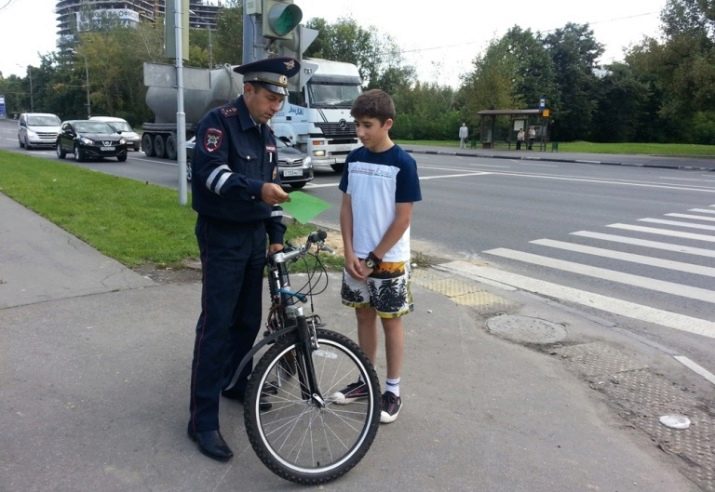
See the video below for the "Cycle Path" sign.





